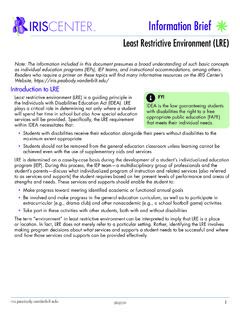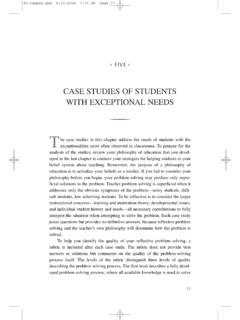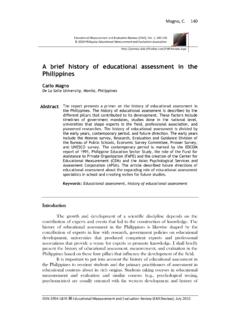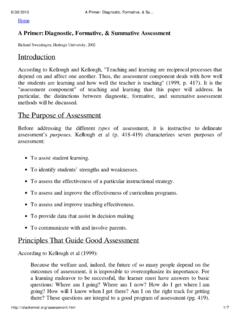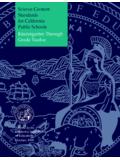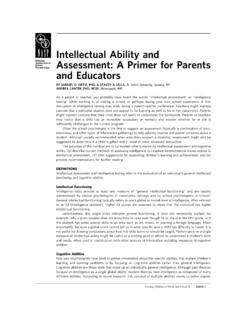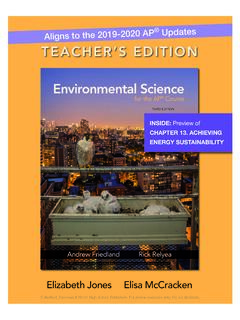Transcription of SPECIAL EDUCATION TERMINOLOGY : DEFINITIONS
1 SPECIAL EDUCATION TERMINOLOGY : DEFINITIONS . Note: The following glossary is an updated and expanded version of the glossary included in the primer for Charter School Authorizers: SPECIAL EDUCATION Requirements and Including Students with Disabilities in Charter Schools from the National Association of State Directors of SPECIAL EDUCATION . ACCOMMODATIONS: Changes in the year and who need a less complex assessment to administration of an assessment, such as setting, demonstrate their knowledge of those standards. scheduling, timing, presentation format, response mode, or others, including any combination of ASSESSMENT: The process of collecting these, that do not change the construct intended information about individuals, groups, or systems to be measured by the assessment or the that relies upon a number of instruments, one of meaning of the resulting scores.
2 Accommodations which may be a test. Therefore, assessment is a are used for equity, not advantage, and serve to more comprehensive term than test. level the playing field for a student with a disability. To be appropriate, assessment ASSISTIVE TECHNOLOGY DEVICE: Any accommodations must be identified in the item, piece of equipment, or product system, student's Individualized EDUCATION IEP or Section whether acquired commercially off the shelf, 504 plan and used regularly during instruction modified, or customized, that is used to increase, and classroom assessment. maintain, or improve the functional capabilities of a child with a disability. The term does not include ACHIEVEMENT TEST: An instrument designed a medical device that is surgically implanted, or to efficiently measure the amount of academic the replacement of such device [34 CFR ].
3 Knowledge and/or skill a student has acquired from instruction. Such tests provide information ASSISTIVE TECHNOLOGY SERVICE: Any that can be compared to either a norm group or a service that directly assists a child with a disability measure of performance. in the selection, acquisition, or use of an assistive technology device [34 CFR ]. It includes ALTERNATE ASSESSMENT: Tests that gather evaluation, purchasing, training, and other information on the standards-based performance services related to the acquisition and use of such and progress of students whose disabilities devices. preclude their valid and reliable participation in general assessments. Alternate assessments AUTHORIZER: The office or organization that measure the performance of a relatively small accepts applications, approves, exercises population of students who are unable to oversight and, after the period of approval, participate in the general assessment system, decides on renewal or revocation of a charter with or without accommodations, as determined school.
4 Some states use different terms for this by the IEP Team. There are different types of role, , sponsor. alternate assessments a state may adopt under the federal requirements. First, states must make AUTISM: According to the 2006 IDEA regulations available an alternate assessment based on 34 CFR (2)(c): (i) Autism means a grade level achievement standards. Then, states developmental disability significantly affecting may develop two other alternates: the "alternate verbal and nonverbal communication and social assessment based on alternate achievement interaction, generally evident before age three, standards" designed for students with the most that adversely affects a child's educational significant cognitive disabilities and the "alternate performance. Other characteristics often assessment based on modified achievement associated with autism are engagement in standards" for students who cannot be expected repetitive activities and stereotyped movements, to achieve grade level standards within one school resistance to environmental change or change in SPECIAL EDUCATION Toolkit 22.
5 Daily routines, and unusual responses to sensory who, by reason thereof, needs SPECIAL EDUCATION experiences. (ii) Autism does not apply if a child's and related services [34 CFR (b)]. educational performance is adversely affected primarily because the child has an emotional In addition: A State that adopts a definition of disturbance, as defined in paragraph (c)(4) of this developmental delay under (b) determines section. (iii) A child who manifests the whether the term applies to children ages three characteristics of autism after age three could be through nine, or to a subset of that age range identified as having autism if the criteria in ( , ages three through five). A state may not paragraph (c)(1)(i) of this section are satisfied. require an LEA to adopt and use the term developmental delay for any children within its CHARTER SCHOOLS: Charter schools are jurisdiction.
6 If an LEA uses the term independent public schools designed and developmental delay for children described in operated by educators, parents, community (b), the LEA must conform to both the leaders, educational entrepreneurs, and others. state's definition of that term and to the age range They are authorized/sponsored by designated that has been adopted by the state. If a state local or state educational organizations who does not adopt the term developmental delay, an monitor their quality and effectiveness, but allow LEA may not independently use that term as a them to operate outside of the traditional system basis for establishing a child's eligibility under this of public schools. Most states use the term part [34 CFR (b)]. "charter school" although there are other terms in use for this type of school, such as "community EARLY INTERVENING SERVICES (EIS): A.
7 School" used in Ohio and "public school academy" new section of the 2004 reauthorization of the in Michigan. IDEA that provides that an LEA may use not more than 15 percent of the amount the LEA receives CHILD WITH A DISABILITY: A child evaluated under Part B of the IDEA in combination with other in accordance with IDEA regulations amounts (which may include amounts other than through as having an intellectual EDUCATION funds) to develop and implement disability, a hearing impairment (including coordinated, early intervening services, which may deafness), a speech or language impairment, a include interagency financing structures, for visual impairment (including blindness), a serious students in kindergarten through grade 12 (with a emotional disturbance (referred to in this part as particular emphasis on students in kindergarten emotional disturbance ), an orthopedic through grade three)
8 Who are not currently impairment, autism, traumatic brain injury, identified as needing SPECIAL EDUCATION or related another health impairment, a specific learning services, but who need additional academic and disability, deaf blindness, or multiple disabilities, behavioral support to succeed in a general and who, by reason thereof, needs SPECIAL EDUCATION environment [34 CFR ]. EDUCATION and related services [34 CFR. (a)(1)]. (See also STUDENT WITH A EARLY INTERVENTION SERVICES: DISABILITY) Programs and services provided to infants and toddlers under Part C of IDEA who are DEVELOPMENTAL DELAY: Child with a experiencing developmental delays or have a disability for children ages three through nine (or diagnosed physical or mental condition that has a any subset of that age range, including ages three high probability of resulting in developmental through five), may include a child: (1) Who is delay.
9 Experiencing developmental delays, as defined by the state and as measured by appropriate EMOTIONAL DISTURBANCE: A condition diagnostic instruments and procedures, in one or exhibiting one or more of the following more of the following areas: physical characteristics over a long period of time and to a development, cognitive development, marked degree that adversely affects a child's communication development, social or emotional educational performance: (A) An inability to learn development, or adaptive development; and (2) that cannot be explained by intellectual, sensory, SPECIAL EDUCATION Toolkit 23. or health factors. (B) An inability to build or performance [34 CFR (c)(6); S. 2781 . maintain satisfactory interpersonal relationships 111th Congress: Rosa's Law]. with peers and teachers. (C) Inappropriate types of behavior or feelings under normal LEAST RESTRICTIVE ENVIRONMENT.
10 Circumstances. (D) A general pervasive mood of (LRE): The IDEA requires that, to the maximum unhappiness or depression. (E) A tendency to extent appropriate, school districts must educate develop physical symptoms or fears associated students with disabilities in the least restrictive with personal or school problems. (ii) Emotional environment, , in the regular classroom with disturbance includes schizophrenia. The term appropriate aids and supports (referred to as does not apply to children who are socially supplementary aids and services ) along with maladjusted, unless it is determined that they their non-disabled peers in the school they would have an emotional disturbance under paragraph attend if not disabled, unless a student's IEP. (c)(4)(i) of this section [34 CFR (c)(4)]. requires some other arrangement.

